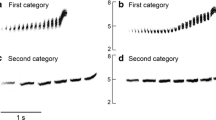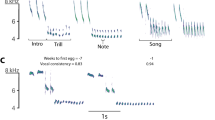Abstract
Acoustic displays with difficult-to-execute sounds are often subject to strong sexual selection because performance levels are related to the sender’s condition or genetic quality. Performance may also vary with age, breeding stage, and motivation related to social context. We focused on within-male variation in four components of trill performance in banded wren (Thryophilus pleurostictus) songs: note consistency, frequency bandwidth, note rate, and vocal deviation. The latter is a composite measure reflecting deviation from the performance limit on simultaneously maximizing both frequency bandwidth and note rate. We compared the changes in these song parameters at three time scales: over the course of years, across the breeding season, and at different times of the day with contrasting agonistic contexts. Vocal deviation decreased and note consistency increased between years, suggesting that experience may improve individual proficiency at singing trills. Consistency also increased across the season, confirming that practice is important for this parameter. Although there was no significant seasonal change in vocal deviation, one of its components, note rate, increased during the season. Neither vocal deviation nor consistency varied with agonistic context. However, note rate increased during playback experiments simulating territorial intrusions compared to dawn chorus singing. The magnitude of a male’s increase in note rate was positively correlated with his aggressive behavior during the playback experiment. Thus consistency, bandwidth, and vocal deviation indicate age, whereas trill rate flexibly indicates the singer’s aggressive motivation. We also found evidence of a within-male trade-off between vocal deviation and consistency.



Similar content being viewed by others
References
Akçay E, Roughgarden J (2007) Extra-pair paternity in birds: review of the genetic benefits. Evol Ecol Res 9:855–868
Ashmore RC, Wild JM, Schmidt MF (2005) Brainstem and forebrain contributions to the generation of learned motor behaviors for song. J Neurosci 25:8543–8554
Ballentine B (2009) The ability to perform physically challenging songs predicts age and size in male swamp sparrows, Melospiza georgiana. Anim Behav 77:973–978
Ballentine B, Hyman J, Nowicki S (2004) Vocal performance influences female response to male bird song: an experimental test. Behav Ecol 15:163–168
Benjamini Y, Hochberg Y (1995) Controlling the false discovery rate—a practical and powerful approach to multiple testing. J R Stat Soc Ser B 57:289–300
Bioacoustics Research Program (2012) XBAT R6: eXtensible BioAcoustics Tool, Cornell Lab of Ornithology, Ithaca, NY 14850. Available from www.birds.cornell.edu/brp/software/xbat-introduction. Accessed 28 Nov 2012
Blackburn TM, Lawton JH, Perry JN (1992) A method of estimating the slope of upper-bounds of plots of body size and abundance in natural animal assemblages. Oikos 65:107–112
Botero CA, de Kort SR (2012) Learned signals and consistency of delivery: a case against receiver manipulation in animal communication. In: Stegmann U (ed) Animal communication theory: information and influence. Cambridge University Press, Cambridge
Botero CA, Rossman RJ, Caro LM, Stenzler LM, Lovette IJ, de Kort SR, Vehrencamp SL (2009) Syllable type consistency is related to age, social status and reproductive success in the tropical mockingbird. Anim Behav 77:701–706
Bradbury JW, Vehrencamp SL (2011) Principles of animal communication, 2nd edn. Sinauer Associates, Inc., Sunderland
Brandt LSE, Greenfield MD (2004) Condition-dependent traits and the capture of genetic variance in male advertisement song. J Evol Biol 17:821–828
Brumm H, Ritschard M (2011) Song amplitude affects territorial aggression of male receivers in chaffinches. Behav Ecol 22:310–316
Burt JM, Vehrencamp SL (2005) Dawn chorus as an interactive communication network. In: McGregor PK (ed) Animal communication networks. Cambridge University Press, Cambridge, pp 320–343
Byers J, Hebets E, Podos J (2010) Female mate choice based upon male motor performance. Anim Behav 79:771–778
Cardoso GC, Atwell JW, Hu Y, Ketterson ED, Price TD (2012) No correlation between three selected trade-offs in birdsong performance and male quality for a species with song repertoires. Ethology 118:584–593
Collins SA, de Kort SR, Perez-Tris J, Telleria JL (2009) Migration strategy and divergent sexual selection on bird song. Proc R Soc Lond B 276:585–590
Cooper BG, Mendez JM, Saar S, Whetstone AG, Meyers R, Goller F (2012) Age-related changes in the Bengalese finch song motor program. Neurobiol Aging 33:564–568
Cortopassi KA, Bradbury JW (2006) Contact call diversity in wild orange-fronted parakeet pairs, Aratinga canicularis. Anim Behav 71:1141–1154
Cramer ERA, Price JJ (2007) Red-winged blackbirds Ageliaus phoeniceus respond differently to song types with different performance levels. J Avian Biol 38:122–127
Cramer ERA, Hall ML, de Kort SR, Lovette IJ, Vehrencamp SL (2011) Infrequent extra-pair paternity in the banded wren, a synchronously breeding tropical passerine. Condor 113:637–645
de Kort SR, Eldermire ERB, Cramer ERA, Vehrencamp SL (2009a) The deterrent effect of bird song in territory defense. Behav Ecol 20:200–206
de Kort SR, Eldermire ERB, Valderrama S, Botero CA, Vehrencamp SL (2009b) Trill consistency is an age-related assessment signal in banded wrens. Proc R Soc Lond B 276:2315–2321
Drăgănoiu TI, Nagle L, Kreutzer M (2002) Directional female preference for an exaggerated male trait in canary (Serinus canaria) song. Proc R Soc Lond B 269:2525–2531
DuBois AL, Nowicki S, Searcy WA (2009) Swamp sparrows modulate vocal performance in an aggressive context. Biol Lett 5:163–165
DuBois AL, Nowicki S, Searcy WA (2011) Discrimination of vocal performance by male swamp sparrows. Behav Ecol Sociobiol 65:717–726
Fletcher NH, Riede T, Suthers RA (2006) Model for vocalization by a bird with distensible vocal cavity and open beak. J Acoust Soc Am 119:1005–1011
Forstmeier W, Kempenaers B, Meyer A, Leisler B (2002) A novel song parameter correlates with extra-pair paternity and reflects male longevity. Proc R Soc Lond B 269:1479–1485
Forstmeier W, Burger C, Temnow K, Deregnaucourt S (2009) The genetic basis of zebra finch vocalizations. Evolution 63:2114–2130
Gall MD, Henry KS, Lucas JR (2012) Two measures of temporal resolution in brown-headed cowbirds (Molothrus ater). J Comp Physiol A 198:61–68
Goller F, Suthers RA (1996) Role of syringeal muscles in controlling the phonology of bird song. J Neurophysiol 76:287–300
Hall ML, Molles LE, Illes AE, Vehrencamp SL (2009) Singing in the face of death: male banded wrens Thryophilus pleurostictus sing more to playback in their last breeding season. J Avian Biol 40:217–224
Hoese WJ, Podos J, Boetticher NC, Nowicki S (2000) Vocal tract function in birdsong production: Experimental manipulation of beak movements. J Exp Biol 203:1845–1855
Holveck MJ, de Castro ACV, Lachlan RF, ten Cate C, Riebel K (2008) Accuracy of song syntax learning and singing consistency signal early condition in zebra finches. Behav Ecol 19:1267–1281
Illes AE, Hall ML, Vehrencamp SL (2006) Vocal performance influences male receiver response in the banded wren. Proc R Soc Lond B 273:1907–1912
Janicke T, Hahn S, Ritz MS, Peter HU (2008) Vocal performance reflects individual quality in a nonpasserine. Anim Behav 75:91–98
Jarvis ED (2004) Brains and birdsong. In: Marler P, Slabbekoorn H (eds) Nature’s music: the science of birdsong. Elsevier Academic Press, Boston, pp 226–271
Kipper S, Kiefer S (2010) Age-related changes in birds' singing styles: on fresh tunes and fading voices? Adv Study Behav 41:77–118
Lampe HM, Balsby TJS, Espmark YO, Dabelsteen T (2010) Does twitter song amplitude signal male arousal in redwings (Turdus iliacus)? Behaviour 147:353–365
Lohr B, Dooling RJ, Bartone S (2006) The discrimination of temporal fine structure in call-like harmonic sounds by birds. J Comp Psychol 120:239–251
Mendez JM, Mindlin GB, Goller F (2012) Interaction between telencephalic signals and respiratory dynamics in songbirds. J Neurophysiol 107:2971–2983
Molles LE, Vehrencamp SL (1999) Repertoire size, repertoire overlap, and singing modes in the Banded Wren (Thryothorus pleurostictus). Auk 116:677–689
Nemeth E, Kempenaers B, Matessi G, Brumm H (2012) Rock sparrow song reflects male age and reproductive success. PLoS One 7:e43259
Pasch B, George AS, Campbell P, Phelps SM (2011) Androgen-dependent male vocal performance influences female preference in Neotropical singing mice. Anim Behav 82:177–183
Podos J (1997) A performance constraint on the evolution of trilled vocalizations in a songbird family (Passeriformes: Emberizidae). Evolution 51:537–551
Podos J (2001) Correlated evolution of morphology and vocal signal structure in Darwin's finches. Nature 409:185–188
Podos J, Lahti DC, Moseley DL (2009) Vocal performance and sensorimotor learning in songbirds. Adv Study Behav 40:159–195
Poesel A, Nelson DA, Gibbs HL (2012) Song sharing correlates with social but not extrapair mating success in the white-crowned sparrow. Behav Ecol 23:627–634
Riede T, Suthers RA, Fletcher NH, Blevins WE (2006) Songbirds tune their vocal tract to the fundamental frequency of their song. Proc Natl Acad Sci USA 103:5543–5548. doi:10.1073/pnas.0601262103
Ritschard M, Brumm H (2012) Zebra finch song reflects current food availability. Evol Ecol 26:801–812
Ritschard M, Riebel K, Brumm H (2010) Female zebra finches prefer high-amplitude song. Anim Behav 79:877–883
Ritschard M, van Oers K, Naguib M, Brumm H (2012) Song amplitude of rival males modulates the territorial behaviour of great tits during the fertile period of their mates. Ethology 118:197–202
Rivera-Gutierrez HF, Pinxten R, Eens M (2010) Multiple signals for multiple messages: great tit, Parus major, song signals age and survival. Anim Behav 80:451–459
Rivera-Gutierrez HF, Pinxten R, Eens M (2011) Songs differing in consistency elicit differential aggressive response in territorial birds. Biol Lett 7:339–342
Rivera-Gutierrez HF, Pinxten R, Eens M (2012) Tuning and fading voices in songbirds: age-dependent changes in two acoustic traits across the life span. Anim Behav 83:1279–1283
Sakata JT, Vehrencamp SL (2012) Integrating perspectives on vocal performance and consistency. J Exp Biol 215:201–209
Sakata JT, Hampton CM, Brainard MS (2008) Social modulation of sequence and syllable variability in adult birdsong. J Neurophysiol 99:1700–1711
Simmons LW, Tinghitella RM, Zuk M (2010) Quantitative genetic variation in courtship song and its covariation with immune function and sperm quality in the field cricket Teleogryllus oceanicus. Behav Ecol 21:1330–1336
Spencer KA, Wimpenny JH, Buchanan KL, Lovell PG, Goldsmith AR, Catchpole CK (2005) Developmental stress affects the attractiveness of male song and female choice in the zebra finch (Taeniopygia guttata). Behav Ecol Sociobiol 58:423–428
Trillo PA, Vehrencamp SL (2005) Song types and their structural features are associated with specific contexts in the banded wren. Anim Behav 70:921–935
van de Pol MV, Wright J (2009) A simple method for distinguishing within- versus between-subject effects using mixed models. Anim Behav 77:753–758
Vehrencamp SL, Hall ML, Bohman ER, Depeine CD, Dalziell AH (2007) Song matching, overlapping, and switching in the banded wren: the sender's perspective. Behav Ecol 18:849–859
Welch AM, Semlitsch RD, Gerhardt HC (1998) Call duration as an indicator of genetic quality in male gray tree frogs. Science 280:1928–1930
Zann R, Cash E (2008) Developmental stress impairs song complexity but not learning accuracy in non-domesticated zebra finches (Taeniopygia guttata). Behav Ecol Sociobiol 62:391–400
Acknowledgments
We thank the Área de Conservación Guanacaste for permission to work in Santa Rosa National Park and the park staff, especially Roger Blanco and María Marta Chavarría, for the logistical support in Costa Rica. Anya Illes, Erin Eldermire, Jessica Niederer, Stephanie Lessard-Pilon, Elizabeth Ochoa, and Kate Neville assisted with the field recording. Jack Bradbury provided comments on the manuscript. This work was funded by NIMH grant R01-MH60461.
Ethical standards
The experimental methods for this study complied with current rules and regulations within the USA.
Conflicts of interest
The authors declare that they have no conflict of interest.
Author information
Authors and Affiliations
Corresponding author
Additional information
Communicated by H. Brumm
Electronic supplementary material
Below is the link to the electronic supplementary material.
ESM 1
(PDF 2330 kb)
Rights and permissions
About this article
Cite this article
Vehrencamp, S.L., Yantachka, J., Hall, M.L. et al. Trill performance components vary with age, season, and motivation in the banded wren. Behav Ecol Sociobiol 67, 409–419 (2013). https://doi.org/10.1007/s00265-012-1461-x
Received:
Revised:
Accepted:
Published:
Issue Date:
DOI: https://doi.org/10.1007/s00265-012-1461-x




